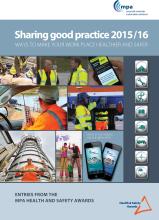
Fatalities fuel attention on safer by design, says Martin Isles, chairman,
On 3 November 2011, the author attended a
Addressed by Andrew Foster, managing director of
In 2007, Scottish Coal, part of
As with similar incidents, a combination of causes allegedly involved human error compounded by serious shortfalls in mobile equipment design, despite compliance with CE-mark requirements.
This article highlights the lessons, which are still to be learned by many manufacturers. It is the ‘design vacuum’ that is addressed by the internationally acclaimed Safer by Design initiative (%$Linker:
The Pennyvenie double fatality illustrates factors, including: _ Site rules to be realistic, well communicated and strictly enforced.
• Clear-cut logistical controls required.
• Light vehicles to be segregated from heavy vehicles, wherever possible.
• Avoidance of in-cab distractions, for example mobile phones, newspapers and iPods.
• Necessity of good communications and clarity of vehicle identifi cation.
• Necessity of 100% all-round vision, preferably to ground level.
• Avoidance of driver sensory overload in provision of aids to all-round vision.
• If vehicles of same/similar colour, apply perimeter marking in contrasting colour.
(Safer by Design addresses many more issues at %$Linker:
Events that led up to the tragedy at Pennyvenie were that several large rigid dump trucks were waiting to be loaded at a face where an excavator, situated on an elevated rock pile, had encountered operational diffi culties.
Two maintenance fi tters entered the operational area in a Land Rover, stopping approximately 7m from the offside front of one of the dump trucks. The excavator was signalled to come down off the rock pile, and on seeing this one of the dump truck drivers decided to leave the area but took a short-cut by turning on full-lock to his blind side, colliding with the Land Rover. It is alleged the dump truck backed up a fraction on encountering resistance and “had another go,” this time crushing the Land Rover, whose two occupants were killed.
A reconstruction was carried out by Scottish Coal. From the dump truck driving position, a small area of the Land Rover roof was just visible. Both vehicles, however, were white so there was no contrast. The Land Rover did not have a roll-cage, neither was it equipped with a ‘buggy-whip’.
The dump truck driver would have had a better chance of seeing the Land Rover arrive had it not been for the obstruction caused by a large battery box, with adjacent fi re extinguishers, located on the bonnet area to the offside of the driver. Crucially, there was no offside CCTV camera supplied.
Detailed charts were assembled showing the visible and non-visible areas around the dump truck. Today, SRG dump trucks have seven mirrors; rear-view CCTV, and offside CCTV to complement the driver’s direct vision. Radios are required as well as bumperheight fast-fi ll refuelling, plus a machine isolator switch operable from ground level.
No mobile phones, iPods, MP3s or similar devices are allowed to be used, and the reading of a newspaper in the cab is a disciplinary offence as is unauthorised entry into an operational area. Soft-skinned vehicles now have physically segregated access routes wherever possible; radios must be operational at all times, and ‘buggy-whips’ with fl ags at eye-level for visibility to dumper drivers.
An interesting new development in all-round vision is being trialled by Terex at an SRG site comprising a four-camera system deployed, one at each corner of a large quarry vehicle, the outputs from which are electronically ‘stitched’ to produce a view covering 8m out from the truck, in all directions.
One of the main determinations from the fatal accident inquiry was that there should be collaboration between operators, manufacturers and the Health and Safety Executive (HSE) to establish common industry standards.
CoalPro, one of the founding members of the Safer by Design initiative, has established a technical working group for plant specifi cations. Encouragingly, there was agreement at the meeting that all parties should aim for a minimal number of alternative ‘build cards’ and that this would represent a major step forward. The positive role of Safer by Design was thus drawn into sharp focus.






